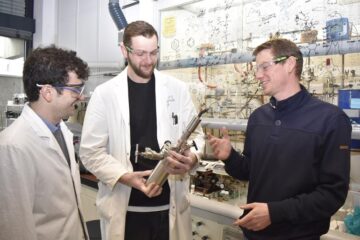The secret of the turtle shell

The evolutionary riddle of the turtle shell is one step closer to being solved thanks to groundbreaking research published this week in Science. A team of Japanese scientists has uncovered anatomical clues charting the developmental path by which the turtle acquired its shell.
Turtle morphology poses a unique puzzle in that the turtle's scapulae (shoulder blades), situated outside the ribs in other animals, are found inside its shell (which is formed from the bones equivalent to ribs in other species). To explain this inside-out skeletal morphology, researchers at the Laboratory for Evolutionary Morphology of the RIKEN Center for Developmental Biology compared embryonic development of the turtle to that of chicken and mice. While muscles and skeletons initially developed in a similar way, turtle embryo development diverged at a late stage, with the ventral part of the body wall folding inwards together with the scapula, a step made possible by the anatomical layout of the turtle embryo.
Their findings also indicate a resemblance between the early form of the turtle embryo and that of Odontochelys, a 220 million-year-old fossil species unearthed in China last year, believed to represent the ancestor of all modern turtles. Based on their results, the research group has concluded that modern turtle anatomy results from the late development of ribs in an Odontochelys-like ancestor, unraveling the long-standing mystery of the turtle and its shell.
For more information, please contact
Dr. Hiroshi Nagashima
Laboratory for Evolutionary Morphology
RIKEN Center for Developmental Biology
Tel: +81-78-306-3064 / Fax: +81-78-306-3370
Ms. Saeko Okada (PI officer)
Global Relations Office
RIKEN
Tel: +81-48-462-1225 / Fax: +81-48-467-9443
Mail: koho@riken.jp
Media Contact
All latest news from the category: Life Sciences and Chemistry
Articles and reports from the Life Sciences and chemistry area deal with applied and basic research into modern biology, chemistry and human medicine.
Valuable information can be found on a range of life sciences fields including bacteriology, biochemistry, bionics, bioinformatics, biophysics, biotechnology, genetics, geobotany, human biology, marine biology, microbiology, molecular biology, cellular biology, zoology, bioinorganic chemistry, microchemistry and environmental chemistry.
Newest articles

Lower dose of mpox vaccine is safe
… and generates six-week antibody response equivalent to standard regimen. Study highlights need for defined markers of mpox immunity to inform public health use. A dose-sparing intradermal mpox vaccination regimen…

Efficient, sustainable and cost-effective hybrid energy storage system for modern power grids
EU project HyFlow: Over three years of research, the consortium of the EU project HyFlow has successfully developed a highly efficient, sustainable, and cost-effective hybrid energy storage system (HESS) that…

Safer alternative for an explosive reaction
The chemical industry has been using a reaction with explosive chemicals for over 100 years – now Mülheim scientists have discovered a safer alternative. The Ritter Group of the Max…





















